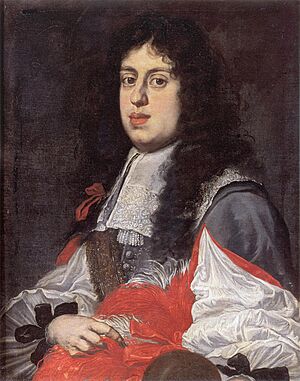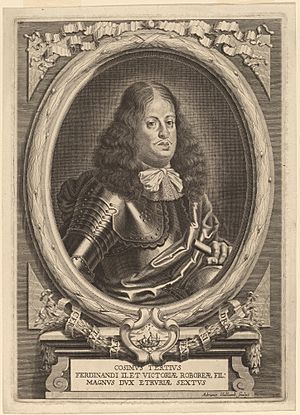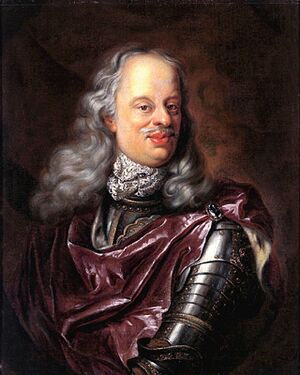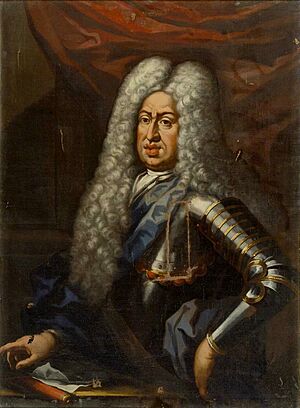Cosimo III de' Medici, Grand Duke of Tuscany facts for kids
Quick facts for kids Cosimo III |
|||||
|---|---|---|---|---|---|
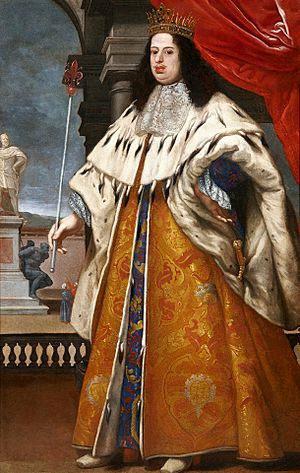
Cosimo in granducal robes, with Tuscan regalia
|
|||||
| Grand Duke of Tuscany | |||||
| Reign | 23 May 1670 – 31 October 1723 | ||||
| Predecessor | Ferdinando II | ||||
| Successor | Gian Gastone I | ||||
| Born | 14 August 1642 Pitti Palace, Florence, Tuscany |
||||
| Died | 31 October 1723 (aged 81) Pitti Palace, Florence, Tuscany |
||||
| Burial | Basilica of San Lorenzo, Tuscany | ||||
| Spouse | Marguerite Louise d'Orléans | ||||
| Issue Detail |
Ferdinando, Grand Prince of Tuscany Anna Maria Luisa, Electress Palatine Gian Gastone, Grand Duke of Tuscany |
||||
|
|||||
| House | Medici | ||||
| Father | Ferdinando II de' Medici | ||||
| Mother | Vittoria Della Rovere | ||||
| Religion | Catholicism | ||||
Cosimo III de' Medici was a powerful ruler of Tuscany, a region in Italy, for 53 years. He was born on August 14, 1642, and ruled as Grand Duke from 1670 until his death on October 31, 1723. He was the sixth Grand Duke from the famous Medici family. His time as ruler was the longest in Tuscany's history. During his reign, Tuscany faced many economic challenges. After he died, his son, Gian Gastone, became the next Grand Duke.
Cosimo married Marguerite Louise d'Orléans, who was a cousin of the French King Louis XIV. Their marriage was quite difficult. Marguerite Louise eventually left Tuscany to live in a convent in France. They had three children: Ferdinando, Anna Maria Luisa, and Gian Gastone. Gian Gastone later became the last Medici ruler of Tuscany.
Later in his life, Cosimo tried to make his daughter, Anna Maria Luisa, the next ruler of Tuscany. However, Charles VI, Holy Roman Emperor, did not agree. Tuscany was part of the Emperor's lands, and he felt he was the only one who could decide who would rule next. Cosimo's plans did not work out. When his younger son, Gian Gastone, died in 1737, Tuscany was taken over by the House of Lorraine.
Contents
Cosimo's Early Life
Becoming the Heir
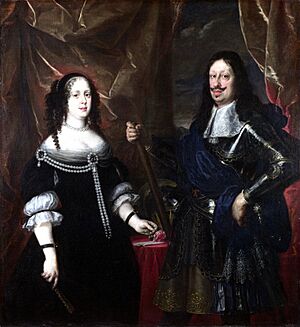
Cosimo de' Medici was born on August 14, 1642. He was the oldest son of Vittoria della Rovere and Ferdinando II de' Medici, Grand Duke of Tuscany. His parents had lost two children before him. His father, Grand Duke Ferdinando, wanted Cosimo to have an excellent science education. But his mother, Grand Duchess Vittoria, was very religious and disagreed. She wanted him to have a religious education, and she got her way. Volunnio Bandinelli, a religious teacher from Siena, became Cosimo's tutor. He was very similar to Cosimo's mother.
When he was young, Cosimo loved sports. His uncle, Gian Carlo de' Medici, once wrote that Cosimo was a very good shot. At age 11, Cosimo shot five pigs with five shots. A visitor from Lucca praised young Cosimo greatly. However, another visitor later described him as "melancholy."
By 1659, Cosimo stopped smiling in public. He often visited churches and spent time with priests. This worried his father, Grand Duke Ferdinando. Cosimo's only sibling, Francesco Maria de' Medici, was born the next year.
His Marriage to Marguerite Louise

Marguerite Louise d'Orléans was a granddaughter of Henry IV of France. She married Cosimo on April 17, 1661, in Paris, though they were not together for the ceremony. She arrived in Tuscany on June 12 and entered Florence on June 20 with a grand celebration. As a wedding gift, Grand Duke Ferdinando gave her a large pearl.
Their marriage was unhappy from the start. A few nights after her arrival, Marguerite Louise demanded the Tuscan crown jewels for herself. Cosimo refused. The jewels she did get were almost smuggled out of Tuscany by her helpers. But Ferdinando's agents stopped them.
Marguerite Louise spent a lot of money, which worried Ferdinando. Tuscany's treasury was almost empty. The economy was so bad that people in the countryside started trading goods instead of using money. In August 1663, Marguerite Louise gave birth to a boy, Ferdinando. Two more children followed: Anna Maria Luisa in 1667 and Gian Gastone in 1671.
Ferdinando asked King Louis XIV of France to help with his daughter-in-law's behavior. Marguerite Louise wanted to return to France. She often embarrassed Cosimo. She even insisted on having French cooks because she feared the Medici family would poison her. In September 1664, Marguerite Louise left her rooms in the Pitti Palace. Cosimo moved her to Villa Lapeggi. There, she was watched by soldiers and courtiers. The next year, she made up with the family. But after Anna Maria Luisa's birth in August 1667, Marguerite Louise got smallpox. She blamed Cosimo for all her problems.
Cosimo's European Journeys
Grand Duke Ferdinando encouraged Cosimo to travel around Europe. He hoped it would distract him from Marguerite Louise's constant anger. On October 28, 1667, Cosimo arrived in Tyrol. He was hosted by his aunt, Anna de' Medici. He traveled by boat down the Rhine river to Amsterdam. There, he met the famous painter Rembrandt van Rijn. From Amsterdam, he went to Hamburg, where the Queen of Sweden was waiting for him. He returned to Florence in May 1668.
This trip helped Cosimo. His health and confidence improved. However, his wife's continued dislike for him soon undid these improvements. Grand Duke Ferdinando worried about Cosimo's health again. So, he sent him on a second trip in September 1668.
On this trip, he visited Spain and met the King, Carlos II. By January 1669, he was in Portugal. A storm forced his ship to land in Kinsale, Ireland. From there, he went to England and met King Charles II. Cosimo was welcomed by the Universities of Oxford and Cambridge. This was because his father was seen as a protector of Galileo from the Inquisition. He met scientists like Robert Hooke, Isaac Newton, and Robert Boyle. Cosimo bought a machine built by Samuel Morland. In London, he stayed at St. Albans House.
On his way back, he traveled through the Dutch Republic again. This time, he bought a self-portrait that Rembrandt had just finished. Passing through Aachen, Cosimo visited King Louis XIV and his mother-in-law, Marguerite of Lorraine, in Paris. He arrived back in Florence on November 1, 1669. His travels were written down in a detailed journal by his travel companion, Lorenzo Magalotti.
Cosimo's Reign as Grand Duke
Marguerite Louise Leaves Tuscany
Ferdinando II died on May 23, 1670. He was buried in the Basilica of San Lorenzo. At the time of his death, Tuscany had about 720,000 people. Cities like Pisa and Siena were struggling.
Grand Duchess Marguerite Louise and Cosimo's mother, Dowager Grand Duchess Vittoria, both wanted power. After a long struggle, Vittoria won. Cosimo gave his mother control over the daily running of the state. Cosimo III started his reign with great energy. He tried to fix the state's money problems and allowed people to ask him to settle their disagreements. But he soon lost interest in managing the state. Vittoria gained more power by joining the Grand Duke's special council. Marguerite Louise had no political power. She focused on her son Ferdinando's education and argued with Vittoria. This only made Cosimo side more with his mother. During this time, on the first anniversary of Ferdinando II's death, Gian Gastone was born to Cosimo and Marguerite Louise.
Marguerite Louise pretended to be sick in early 1672. King Louis XIV sent his doctor to check on her. The doctor did not help Marguerite Louise's plan to be sent to France. In December, she went on a religious trip to Villa di Pratolino and never returned to Florence. Instead, she chose to live quietly at Poggio a Caiano. Cosimo eventually agreed, but he worried she might run away. So, she was not allowed to leave without his permission. When she rode horses, four soldiers had to go with her. All the doors and windows of the villa also had to be locked. Their disagreements continued until December 26, 1674. After all attempts to make peace failed, Cosimo finally allowed his wife to leave for the Convent of Montmartre in France. She gave up her rights as a French princess. Cosimo gave her money each year. She left the next June, after taking many valuable items from Poggio a Caiano.
Laws and Succession Plans
Without Marguerite Louise to worry about, Cosimo focused on other matters. Meanwhile, in Lorraine, Charles V had no heir. Marguerite-Louise, as the daughter of a Lorraine princess, said her older son, Ferdinando, should inherit the duchy. Grand Duke Cosimo tried to get other countries to agree to this, but it didn't work. The Treaties of Nijmegen, which ended a war, did not support Cosimo's plans. The issue of Lorraine was settled when Charles V had a son in 1679. This ended Cosimo's dream of a Medici family branch ruling in another country.
Years 1679–1685
Cosimo kept track of his wife's actions in France through his representative, Gondi. Marguerite Louise often asked Cosimo for more money. He was shocked by her behavior, especially when she became close with a stable worker. In January 1680, the head of the Montmartre convent asked Cosimo for money to build a water tank. This was after a fire incident where Marguerite Louise's pet dog's basket caught fire. Instead of putting it out, she told the nuns to run away. She had previously threatened to burn down the convent if the Abbess disagreed with her. Cosimo, unable to do much else, wrote angry letters to her. Another incident happened that summer when she bathed in a local river. Cosimo was furious when he heard about it. King Louis XIV grew tired of Florence's complaints. He said that since Cosimo had allowed his wife to go to France, he had no right to interfere in her life. After this, Cosimo became very ill. His doctor, Francesco Redi, helped him recover. After this, Cosimo finally stopped worrying about his wife's life. In 1682, Cosimo III made his brother, Francesco Maria de' Medici, the Governor of Siena.
The Holy Roman Emperor asked Cosimo to help in a war against the Turks. At first, Cosimo refused. But then he sent weapons and offered to join the Holy League. They defeated the Turks at the Battle of Vienna in September 1683. Cosimo was also concerned about certain social issues. He made a law against Jewish people using Christian wet nurses for their babies. He also increased the number of public executions. A visitor to Florence in November 1685, Gilbert Burnet, wrote that Florence had become much smaller. He said that other states like Siena and Pisa had also shrunk greatly.
Marriage of Grand Prince Ferdinando

In 1686, Cosimo began arranging a marriage for his older son, Ferdinando. He needed Ferdinando to have children because his other sons, Francesco Maria and Gian Gastone, were often sick and unlikely to have children. The main choices for Ferdinando's wife were Violante of Bavaria, a Bavarian princess, Isabel Luisa of Portugal, and the daughters of the Elector Palatine.
Talks with Portugal were serious but stopped over certain rules. Ferdinando and Isabel Luisa would live in Lisbon. Ferdinando would give up his right to the Tuscan throne unless the Portuguese King had a son. If Isabel Luisa became Queen of Portugal and Cosimo and his other sons died without male heirs, Tuscany would become part of Portugal. Ferdinando refused this plan, and King Louis XIV supported him. Cosimo then looked at Violante of Bavaria. Marrying her would strengthen ties between France and Bavaria. There was one problem: Cosimo's father, Ferdinando II, had advised Violante's father to invest a lot of money in a bank. Soon after, the bank failed. Violante's father was still upset. Cosimo agreed to lower her dowry to make up for the loss. Ferdinando was not impressed with his wife. But Violante greatly impressed the Grand Duke. He wrote that he had never seen such a perfect person.
Royal Highness Title
Duke Victor Amadeus II of Savoy gained the title Royal Highness from Spain and the Holy Roman Empire in June 1689. This made Grand Duke Cosimo very angry. He complained that a duke should not have a higher status than a grand duke. He said it was "unjustly exalted" because the House of Savoy had not grown to be like kings. He also said the Medici family had not lost its power. Cosimo reminded the Emperor of all the times Tuscany had given money and military help to the Empire. The Emperor wanted to avoid problems. He suggested that Anna Maria Luisa should marry the Elector Palatine to make up for the insult. Two years later, the Elector Palatine helped Cosimo and his family get the Royal Highness title. From then on, Cosimo was called His Royal Highness The Most Serene Grand Duke of Tuscany.
Years 1691–1694
King Louis XIV was angry about Anna Maria Luisa marrying his enemy. Cosimo eventually convinced him otherwise. On October 9, 1691, France, England, Spain, and the United Provinces promised not to attack the Tuscan port of Livorno. Meanwhile, the Empire tried to collect taxes from Cosimo and wanted him to join Austria. The Grand Duke replied that if he did, France would send a navy to attack his state. The Emperor reluctantly accepted this excuse. Tuscany was not the only state that owed money to the Emperor. Other parts of Italy also had to pay, but much more than Cosimo.
Cosimo, having little else to do, made more moral laws. This happened at the same time as new taxes, which hurt Tuscany's already weak economy. It was said that a bale of wool sent from Leghorn and Cortona had to pass through ten different customs checks.
Cosimo brought back a law from his father's time that stopped students from going to college outside Tuscany. This made the Jesuits more powerful in education. Someone at the time wrote that no one in Florence could read or write Greek. This was very different from the time of the old republic. In a letter from October 10, 1691, Cosimo's secretary wrote that the Grand Duke would not allow any professor in his university to teach any philosophy except that of Aristotle.
Ferdinando and Violante had been married for over five years by 1694 but had no children. The Grand Duke responded by declaring special days of prayer. He also built a "fertility column" in Florence, which people made fun of. Ferdinando did not spend much time with Violante. Instead, he preferred his favorite, a Venetian named Cecchino de Castris. In the same year, Dowager Grand Duchess Vittoria, Cosimo's mother, died. Her lands were given to her younger son, Francesco Maria de' Medici.
Marriage of Gian Gastone
Cosimo became worried about who would rule Tuscany next after his mother died. Ferdinando had no children, and neither did Anna Maria Luisa. Anna Maria Luisa, who was important to her father, suggested a German princess for Gian Gastone to marry. This princess, Anna Maria Franziska of Saxe-Lauenburg, was very rich. Cosimo again dreamed of a Medici family branch ruling in another country. They were married on July 2, 1697. Gian Gastone and his wife did not get along. He eventually left her in 1708.
Early 18th Century
The 17th century ended with problems for the Grand Duke. He still had no grandchildren. France and Spain would not accept his "royal" status. In May 1700, Cosimo went on a religious trip to Rome. Pope Innocent XII made Cosimo a special church official. This allowed him to see a cloth believed to have been used by Christ. Cosimo was happy with how the Roman people welcomed him. He left Rome with a small piece of Saint Francis Xavier's body.
Carlos II of Spain died in November 1700 without an heir. His death led to the War of the Spanish Succession, which involved all the major European powers. Tuscany, however, stayed neutral. Cosimo recognized Philip, Duke of Anjou, as Carlos's successor. Philip's government refused to give Cosimo the special "Royal" title. Soon after, the Grand Duke accepted control of Siena from Philip. This confirmed his status as a Spanish subject.
Gian Gastone was spending money very quickly in Bohemia and getting into huge debt. The Grand Duke was alarmed. He sent someone to check on the Prince's debts. He was shocked to find that even the Archbishop of Prague was one of Gian Gastone's creditors. To help Gian Gastone, his representative tried to convince Anna Maria Franziska to return to Florence. Gian Gastone wanted to be there. But she refused. Her religious advisor told her stories of other Medici wives who were "poisoned" to keep her in Bohemia.
Tuscan Succession and Later Years
Cosimo's religious devotion had not lessened since his youth. He visited the Florentine Convent of Saint Mark every day. Someone at the time said that "The Grand Duke knows all the monks of Saint Mark at least by sight." However, this was not all he did. He was still trying to convince Anna Maria Franziska to come to Florence. He believed her strange behaviors would stop there. Also, in 1719, he claimed that God asked him to dedicate the Grand Duchy to Saint Joseph.
Leopold I, Holy Roman Emperor, died in May 1705. His successor, Joseph I, began ruling with great energy. After a major Imperial victory, the Emperor sent someone to Florence to collect taxes. These amounted to a huge sum of money. He also wanted to force Cosimo to recognize Archduke Charles as King of Spain. Fearing a French-Dutch invasion, Cosimo III refused to recognize Charles's title. But he did pay some of the taxes.
Grand Prince Ferdinando became very ill. He started losing his memory and did not recognize anyone. Cosimo was very sad. He successfully got help from Pope Clement XI with Anna Maria Franziska. The Pope sent the Archbishop of Prague to talk to her. She used the example of Marguerite-Louise, saying the Pope did not help her. Cosimo wrote desperate letters to his daughter, the Electress Palatine. He told her they had no money in Florence and that his own payments were delayed.
Gian Gastone arrived in Tuscany without his wife in 1708. The Emperor thought it was unlikely that the Medici family would have any more male heirs. He prepared to take over Tuscany, claiming he had a right to it through Medici ancestors. He hinted that when the Grand Prince died, the Tuscans would rebel against Cosimo's strict rule. In an act of desperation, Cosimo had Francesco Maria, a cardinal in the Medici family, give up his religious vows. He then married him to Eleanor of Gonzaga. Two years later, Francesco Maria died, ending any hope of an heir.
With no clear heir, Cosimo thought about bringing back the Republic of Florence. However, this had many challenges. Florence was technically under the Emperor, and Siena was under Spain. The plan was almost approved by the powers meeting in Geertruidenberg. But Cosimo suddenly added that if he and his two sons died before the Electress Palatine, she should rule. And after her death, the republic should be brought back. The proposal failed and was put on hold after Emperor Joseph's death.
Charles VI, Holy Roman Emperor, agreed to meet with the Electress Palatine in December 1711. He concluded that the Electress could succeed, but he, the Emperor, must succeed her. Cosimo and his daughter were shocked by his answer. Realizing he had been too harsh, Charles wrote to Florence agreeing to the plan. He added one condition: Tuscany must not be given to enemies of the House of Austria. At the end of the War of the Spanish Succession, Cosimo did not try to get international promises for his daughter's succession. This was something he would later regret.
Grand Prince Ferdinando finally died on October 30, 1713. On November 26, Cosimo presented a succession bill to the Senate, Tuscany's law-making body. The bill stated that if Gian Gastone died before the Electress Palatine, she should inherit all the lands of the Grand Duchy. The senators cheered. Charles VI was furious. He said that the Grand Duchy was an Imperial land, and only he could choose who would rule next. Elisabeth Farnese, who had a claim to Tuscany through her Medici grandmother, also wanted to rule.
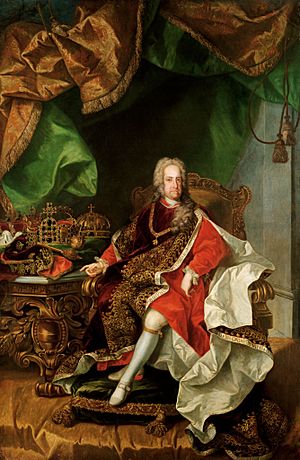
In May 1716, the Emperor told the Electress and the Grand Duke that there was nothing stopping her from becoming ruler. But he added that Austria and Tuscany must soon agree on which royal family would succeed the Medici. To encourage Cosimo to reply faster, the Emperor hinted that Tuscany would gain more land. In June 1717, Cosimo said he wanted the House of Este to rule next. Charles VI's promises never came true. In 1718, he rejected Cosimo's choice, saying a union between Tuscany and Modena was unacceptable. On April 4, 1718, England, France, and the Dutch Republic (and later Austria) chose Don Carlos of Spain as the Tuscan heir. By 1722, the Electress was not even recognized as the heir. Cosimo was left to watch as others decided Tuscany's future.
Johann Wilhelm, Elector Palatine died in June 1717. Anna Maria Luisa returned home in October 1717, bringing many valuable treasures. Cosimo made his older son's widow, Violante of Bavaria, Governor of Siena. This was to clearly define her importance. But it did not stop the two ladies from arguing, which was Cosimo's intention. Cosimo stopped hunting after an accident in January 1717. He accidentally shot and killed a man. He was so upset that he wanted to be judged by a special group of knights. The state of Tuscany showed the decline of its ruler. In a 1718 military review, the army had fewer than 3,000 men. Some were sick and old. The navy had only three ships and 198 crew members. In September 1721, the Grand Duchess died. Instead of leaving her possessions to her children, as agreed in 1674, they went to another princess.
Death and What He Left Behind
On September 22, 1723, the Grand Duke had a two-hour fit of shaking. His health steadily worsened. A church official and the Archbishop of Pisa were with Cosimo on his deathbed. The Archbishop said that Cosimo "required little assistance in order to die well." This was because he had spent his life preparing for death. On October 25, 1723, six days before he died, Grand Duke Cosimo made a final statement. He commanded that Tuscany should remain independent. He also said that Anna Maria Luisa should succeed Gian Gastone without problems. He claimed the right to choose his successor. But these wishes were completely ignored. Six days later, on October 31, he died. He was buried in the Basilica of San Lorenzo, the Medici family's burial place.
Cosimo III left Tuscany as one of the poorest nations in Europe. The treasury was empty, and the people were tired of his strict religious rules. The state itself had become like a pawn in European politics. One lasting thing he did was to establish the Chianti wine region. His son, Gian Gastone, later removed Cosimo's laws against Jewish people. He also lowered taxes and customs fees. Cosimo's failure to keep Tuscany independent led to the House of Lorraine taking over after Gian Gastone's death in 1737.
Cosimo's Children
Cosimo III had three children with Marguerite Louise d'Orléans, a granddaughter of Henry IV of France:
- Ferdinando de' Medici, Grand Prince of Tuscany (born 1663, died 1713) married Violante Beatrice of Bavaria, but they had no children.
- Anna Maria Luisa de' Medici, Electress Palatine (born 1667, died 1743) married Johann Wilhelm, Elector Palatine, but they had no children.
- Gian Gastone de' Medici, Grand Duke of Tuscany (born 1671, died 1737) married Anna Maria Franziska of Saxe-Lauenburg, but they had no children.
Cosimo did not have a good relationship with his older son, Ferdinando. They disagreed about Cosimo's strong religious ideas and Ferdinando's monthly allowance. Cosimo arranged for Ferdinando to marry Violante Beatrice. This marriage was very unhappy and produced no children. Anna Maria Luisa was the Grand Duke's favorite child. She married Johann Wilhelm, and like her brother, had no children. Gian Gastone, who eventually became Grand Duke, disliked his father and his court. Anna Maria Luisa arranged for him to marry Anna Maria Franziska, but this marriage also produced no children.
Honours
| Styles of Cosimo III de' Medici, Most Serene Grand Duke of Tuscany |
|
|---|---|
 |
|
| Reference style | His Royal Highness |
| Spoken style | Your Royal Highness |
![]() From May 23, 1670, to October 31, 1721: Grand Master of the Holy Military Order of St. Stephen Pope and Martyr
From May 23, 1670, to October 31, 1721: Grand Master of the Holy Military Order of St. Stephen Pope and Martyr
Images for kids
See also
 In Spanish: Cosme III de Médici para niños
In Spanish: Cosme III de Médici para niños


